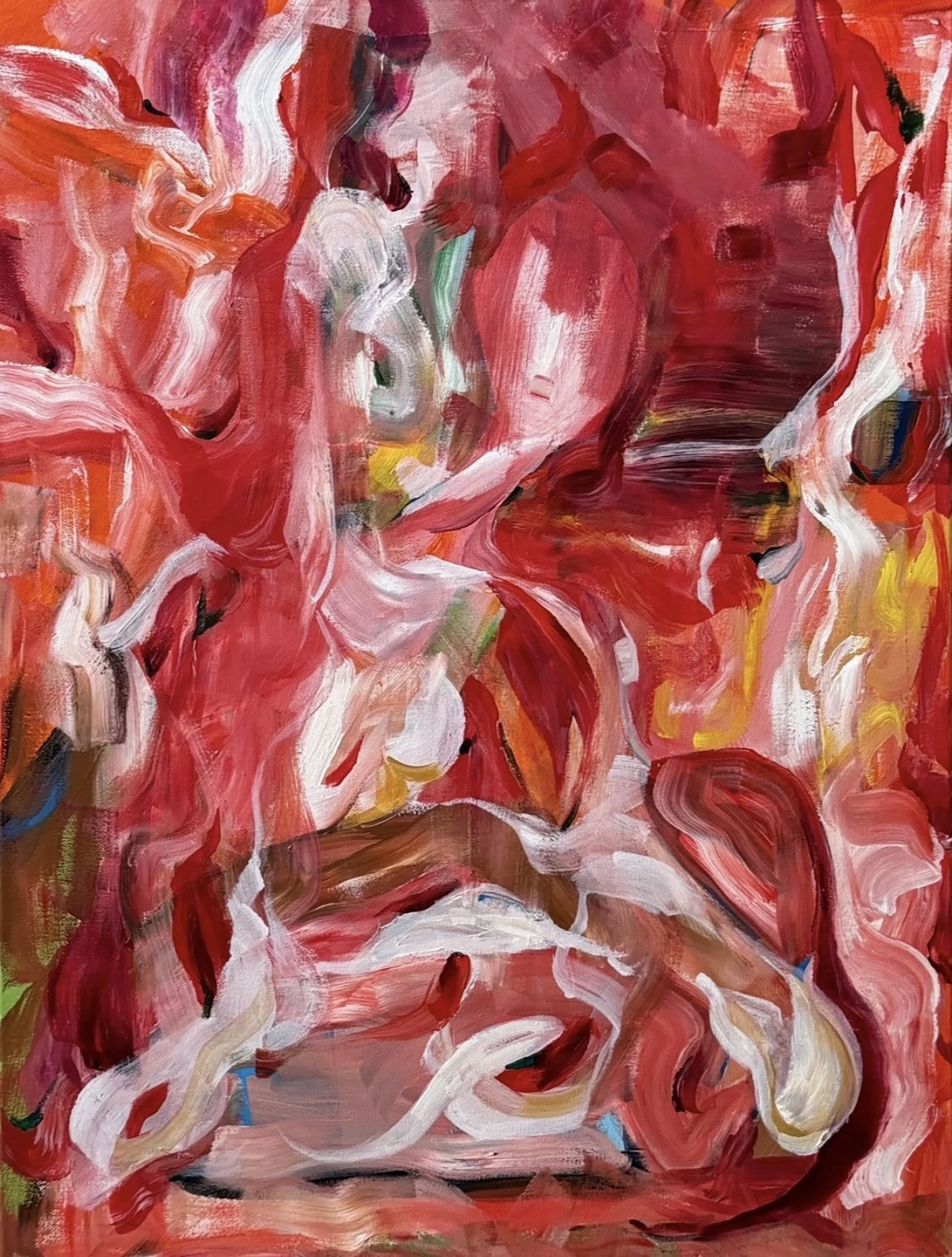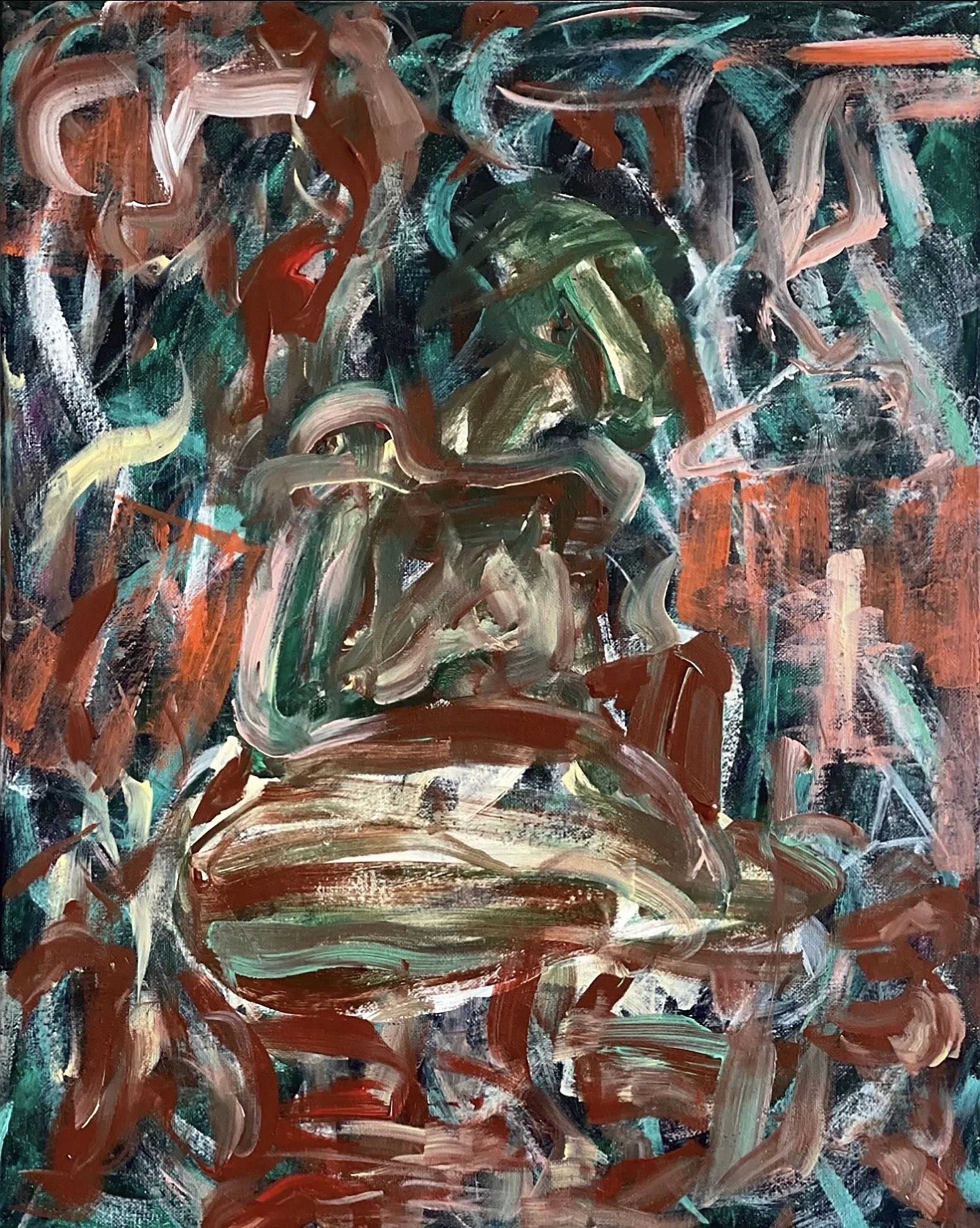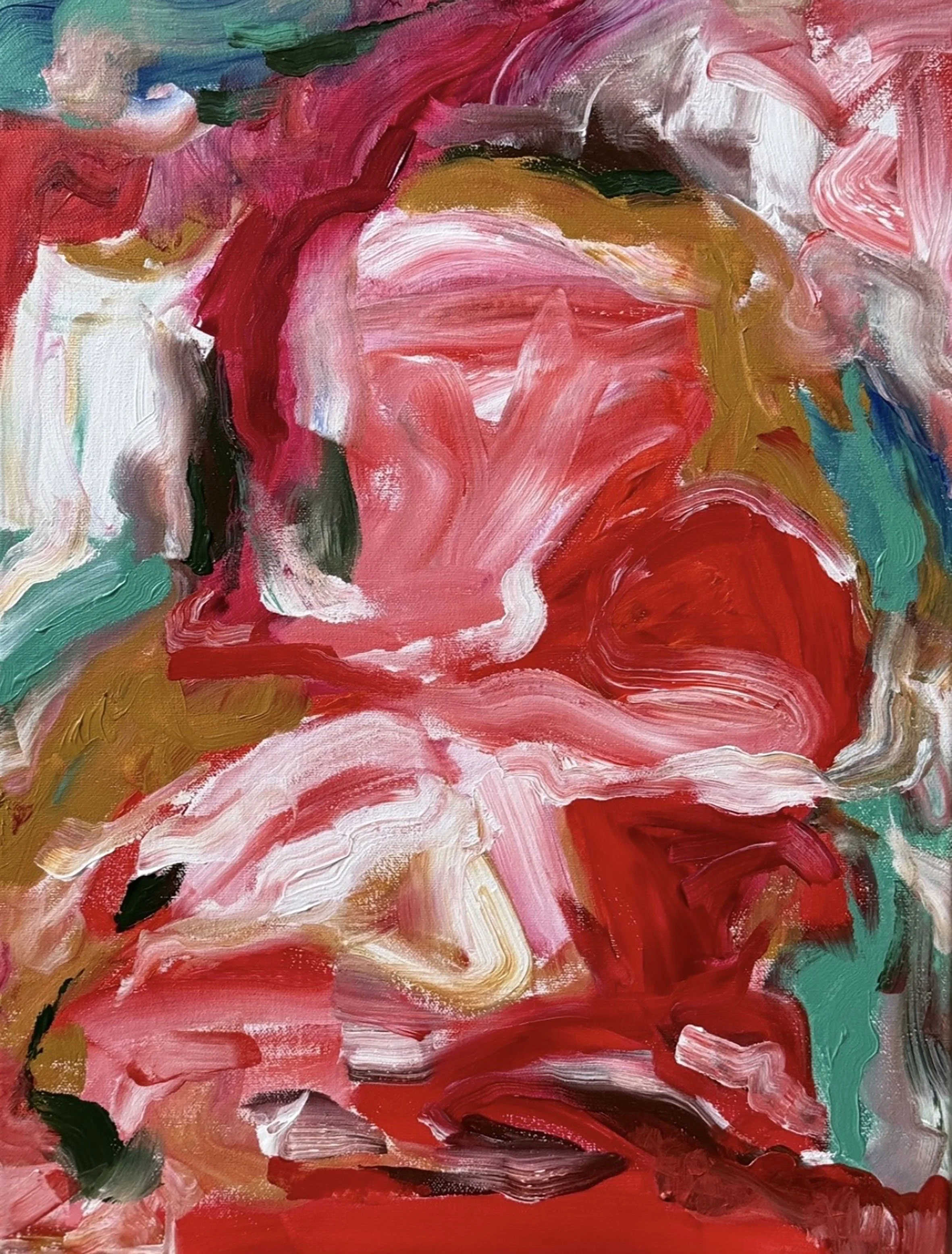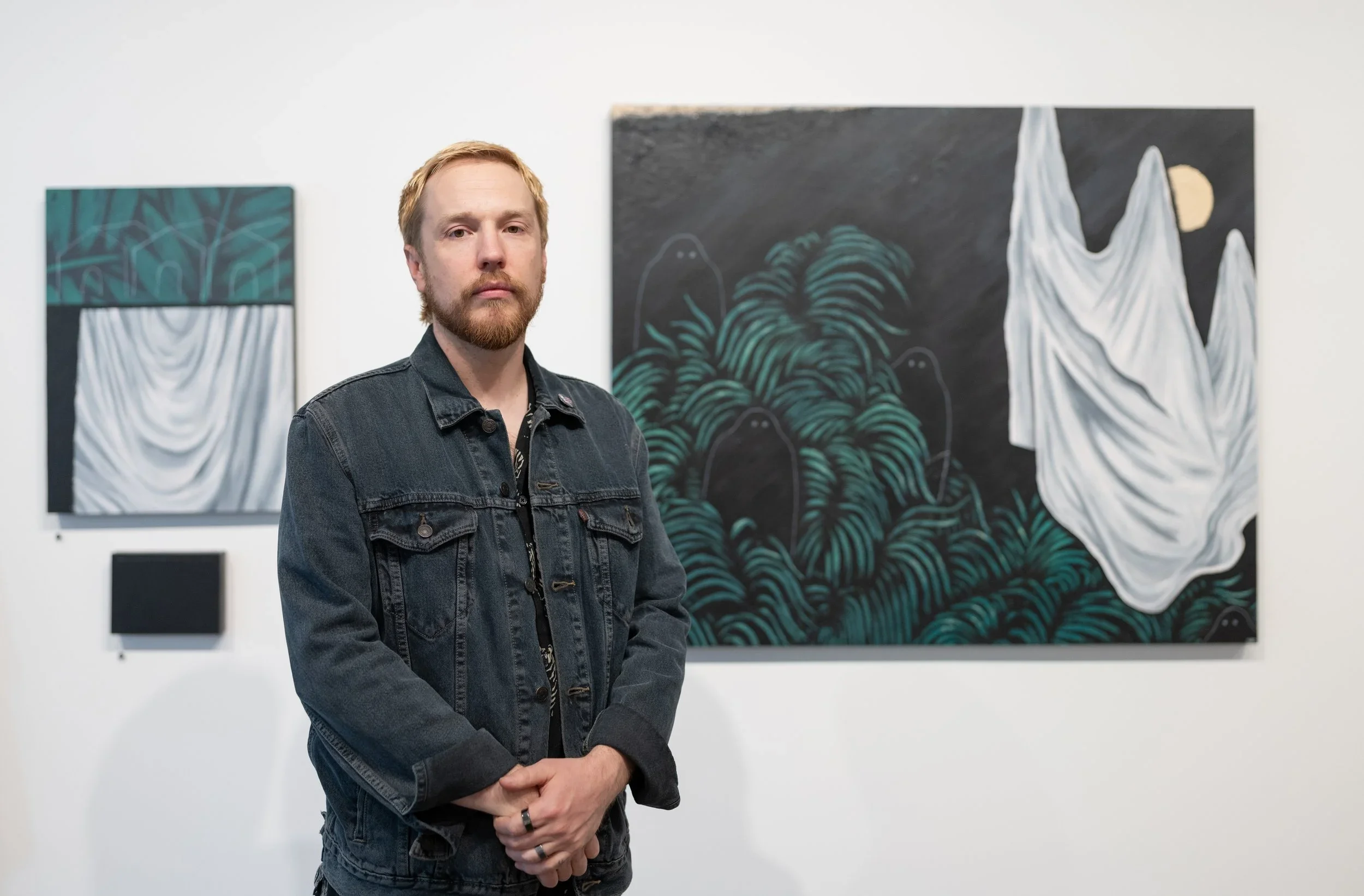10 Questions with Yanhua Feng
AL-TIBA9 ART MAGAZINE ISSUE19 | FEATURED ARTIST
Yanhua Feng - Portrait
Yanhua Feng (b.1965) is a Chinese-born artist based in San Francisco, with studios in Vancouver and Beijing. Her path to painting spans disciplines, cultures, and historical moments. Trained in design in the 1990s, she led major national visual projects during a period of sweeping social transformation in China, including commemorative work for the return of Hong Kong and the design of the China Women and Children’s Museum. These early experiences shaped her understanding of image–making as both state apparatus and personal language.
Feng returned to painting gradually, carving out time between the demands of family life after relocating to Canada. For over a decade, she drew quietly amid caregiving. With her daughter’s departure to study in the United States, Feng moved to the Bay Area and reentered the studio with a renewed urgency. Her large-scale acrylic paintings evoke presence without portraiture: bodies lean, collapse, or hover; brushstrokes bleed and buckle; colour operates as atmosphere, boundary, or refusal.
Working in acrylic on canvas, she constructs layered surfaces that hold contradiction, softness and threat, silence and saturation, nearness and opacity. While abstract, her work is rooted in the emotional architecture of contemporary life: its intimacy, instability, and shifting terrains of care. Female bodies, domestic space, and unspoken gestures recur not as subjects, but as ambient forces.
Her recent exhibitions include the Venice Biennale in Italy, the Salon des Artistes Indépendants (Art Capital) at the Grand Palais in Paris, and a public art installation in New York’s Times Square. In 2025, she participated in a cross-disciplinary video and sound project exploring the blurred boundaries between music, memory, and the visual field. Across all formats, Feng’s work asks how ambiguity and softness can carry political weight – and how abstraction might offer a language for what remains unresolved.
ARTIST STATEMENT
Yanhua Feng’s recent body of work embraces ambiguity, softness, and emotional residue, not as retreat, but as an artistic stance. In a visual culture increasingly shaped by speed, clarity, and spectacle, Feng chooses dissonance and uncertainty as deliberate strategies. Her paintings turn away from narrative closure and toward what remains unresolved: shifting roles, quiet ruptures, and the psychic weight of domestic space.
Working in abstraction, Feng resists the pressure to define or contain. Colour in her work is not decorative or symbolic – it acts as atmosphere, tension, or refusal. Her compositions are often inhabited by fragmented, drifting bodies that lean or dissolve, pushing back against the modernist insistence on formal cohesion. Through layered surfaces and unstable forms, she constructs a visual language that privileges vulnerability over certainty and complexity over clarity.
Feng’s work offers a quiet, persistent resistance to the cultural demands for coherence, particularly around identity, gender, and care. Her paintings do not shout; they listen. They invite slowness. They make space for the emotions that resist naming. In doing so, Feng reclaims softness as a mode of strength and ambiguity as a way of seeing, proposing that dwelling in uncertainty is not a loss, but rather a way to remain open.
Soft Rebellion, Acrylic on canvas, 24x32 in, 2024 © Yanhua Feng
AL-TIBA9 ART MAGAZINE ISSUE19
Get your limited edition copy now
INTERVIEW
Please tell us a bit about yourself. Who are you, and why did you realise you wanted to be an artist?
I’m Yanhua Feng. I was born in China and now live in San Francisco, with workspaces in Beijing and Vancouver. My path into painting wasn’t a lightbulb moment; it happened slowly, almost sideways. I studied design and worked on large-scale national visual projects back in the ‘90s, when images carried a strange double life: part state symbol, part personal projection.
But I didn’t fully understand what it meant to make art until much later, after I’d moved countries, raised a child, and spent years focused on family. In those quiet, off-the-clock moments, drawing at the kitchen table, sketching while waiting, I realised art didn’t need to resolve anything. It could coexist with the mess and the uncertainty, yet still hold meaning. That was the shift. That’s what brought me back to painting, and honestly, that’s still why I do it.
Your artistic path spans design, large-scale projects, and now abstract painting. How would you describe yourself as an artist today?
These days, I consider myself someone who works with emotional structure more than visual hierarchy. I’m less concerned with telling people what to see, and more interested in what they might feel, especially the things that don’t have clear edges. Grief, care, restraint, uncertainty. When I was designing, the goal was to make things legible – to communicate clearly, often within tight constraints. Painting, for me, does the opposite. It opens things up. I moved from shaping messages for institutions to making work that listens more than it speaks. That shift, from clarity to complexity, wasn’t just technical; it was personal. It’s how I think now, and how I live.
Rootless Fire, Acrylic on canvas, 18x24 in, 2024 © Yanhua Feng
You gradually returned to painting, often drawing in quiet moments between caregiving tasks. How has this deeply personal context influenced the themes and sensibilities that emerge in your work?
For many years, my creative time ran parallel to family life. I was raising a child, managing a household, and making choices that prioritised others before myself, not out of sacrifice, but as part of a rhythm I stepped into fully. I wasn’t in the studio every day, but I was never far from image-making. I sketched when I could, at the kitchen table, late at night, in the quiet between moments. Those pauses held a different kind of clarity.
They also sharpened my attention. I began to notice the weight of what’s unspoken, the emotional tension in ordinary scenes, the way care lives in restraint. That kind of slow perception is still at the core of how I paint.
My work isn’t about loud gestures or quick conclusions. It’s about holding emotional space, about honouring complexity without having to name everything. In a way, those years didn’t take me away from art, they prepared me to see more deeply, and to make work that listens as much as it speaks.
Working primarily in acrylic on canvas, what drew you to this medium, and how does it serve your exploration of ambiguity, softness, and emotional residue?
Acrylic gives me room to change my mind. That’s probably the biggest thing. I can build, scrape back, blur, adjust, all in the same sitting. I like that it doesn’t wait for perfection. It’s fast enough to keep up with me, but forgiving when I need to shift direction.
I didn’t choose acrylic for efficiency, I chose it because it accommodates uncertainty. The surfaces in my work are always in conversation with what came before, what was covered, what was left visible, what insisted on staying.Acrylic is ideal for that kind of negotiation. It lets things accumulate and disappear at the same time.
Something Still Biting, Acrylic on canvas, 16x20 in, 2024 © Yanhua Feng
Where the Angels Look Away, Acrylic on canvas, 24x32 in, 2024 © Yanhua Feng
Your paintings evoke bodies without portraiture. Could you share how you arrive at these forms and what they mean to you in terms of visual language?
The body shows up in my work like a rumour. It’s there, but not pinned down. A curve might feel like a shoulder, a fold might suggest a leg, but I’m not trying to “draw” anyone. I’m more interested in what a body feels like than what it looks like.
These forms usually emerge through the process. I don’t set out to paint a figure, it’s more that gestures, gravity, or tension start to feel bodily. By not fully resolving them, I leave space for projection. You can find yourself in the form, or not. That ambiguity is important to me. It keeps the painting open, alive.
You speak about resisting clarity and narrative closure in flavor of uncertainty and dissonance. What does this creative choice allow you to express that more literal forms might not?
Literal forms often want to tell you something. And sometimes that’s great. But I’ve always been more drawn to the stuff we can’t explain so easily, emotional contradictions, shifting identities, that constant state of almost-knowing.
When things are unresolved, they stay in motion. And I like that. There’s more room to breathe, more room to feel. I think we live in a moment where there’s so much pressure to “figure things out,” to brand yourself, to tie everything into a neat story. My work pushes against that. It sits in the blur, in the not-yet. That’s not just a visual strategy – it’s a way of being.
Colour in your work functions as atmosphere, tension, or refusal rather than decoration, as you mention in your statement. Could you walk us through your process of choosing and layering colour to build these shifting emotional spaces?
Colour is never just there to be pretty. I don’t think about it in symbolic terms either. For me, it’s more like a mood, or a kind of pressure in the painting, something that pushes, resists, or quietly holds space. I tend to start with a certain emotional tone, sometimes it’s tension, sometimes it’s hesitation, and then let the colour respond to that.
I work directly on the canvas, mixing as I go. I don’t over-plan. I like to let things unfold and sometimes even go wrong. That kind of “letting things slip” is actually important to me – it’s a way of working that allows for contradiction, imbalance, and even a bit of stubbornness on the surface. I guess you could say I trust the painting more when it doesn’t resolve too neatly.
I’m not trying to create harmony. I’m more interested in friction, cool against warm, soft next to something sharp. That tension is where things start to feel alive. In a way, I think we live in a time that really craves clarity and perfection. But I’m more drawn to what happens when things misalign. There’s a kind of truth there. Maybe not a clean truth, but a human one.
Nothing Left to Say, Acrylic on canvas, 18x24 in, 2024 © Yanhua Feng
Your work often asks the viewer to slow down and sit with what feels unresolved. What role do you hope viewers play in completing the meaning of your work?
I don’t think of viewers as passive. They’re part of the painting, really. When someone brings their own pace, their ownmess, their own emotional baggage to the work, that’s when it starts to live outside of me.
My hope is that the painting holds up a mirror, but not a clean one. It doesn’t tell you what to feel. It just gives you time and space to feel something. If you walk away unsure, that’s okay. I’m not interested in closure. I’m interested in what happens when you stay with the discomfort for a little longer.
You’ve recently expanded into cross-disciplinary collaborations, including video and sound. How has this exploration into new formats influenced your understanding of painting and abstraction?
Working with sound and time-based media made me realise just how much painting has to do with rhythm. When you see a moving image or hear a pulse, you start to think differently about pacing, even on a static surface.
These collaborations didn’t change my approach so much as expand it. I started paying more attention to silence, to buildup, to interruption. Painting doesn’t need to imitate other media, but it can absorb their logic. I’m still a painter at heart, but I’m less attached to the wall now. I don’t mind if the work spills across forms or rooms, it just has to carry the same emotional charge.
Flesh and Ornament, Acrylic on canvas, 36x48 in, 2024 © Yanhua Feng
Lastly, are there new themes, mediums, or questions you’re eager to explore in your future projects and what continues to drive your practice forward?
Lately, I’ve been thinking about fragmentation, not just physical, but emotional. Our attention is scattered. Our relationships are stretched thin. Even memory feels unstable, shifting. I’m interested in how painting, without becoming illustrative, can hold that sense of broken continuity, of something that resists neat resolution.
I’m also exploring the use of more materials within painting itself. Not to leave the medium behind, but to deepen its range, to create friction, density, or a shift in surface that might trigger a different kind of response. It’s still painting, but I want it to feel more embodied, more layered, sometimes even more difficult.
What keeps me going is the belief that abstraction still has room to ask real questions. It can hold tension without rushing to clarity. It can suggest a feeling without pinning it down. I’m not after perfection, I’m after something that feels alive, something that pushes back a little. That’s enough.
Artist’s Talk
Al-Tiba9 Interviews is a curated promotional platform that offers artists the opportunity to articulate their vision and engage with our diverse international readership through insightful, published dialogues. Conducted by Mohamed Benhadj, founder and curator of Al-Tiba9, these interviews spotlight the artists’ creative journeys and introduce their work to the global contemporary art scene.
Through our extensive network of museums, galleries, art professionals, collectors, and art enthusiasts worldwide, Al-Tiba9 Interviews provides a meaningful stage for artists to expand their reach and strengthen their presence in the international art discourse.























